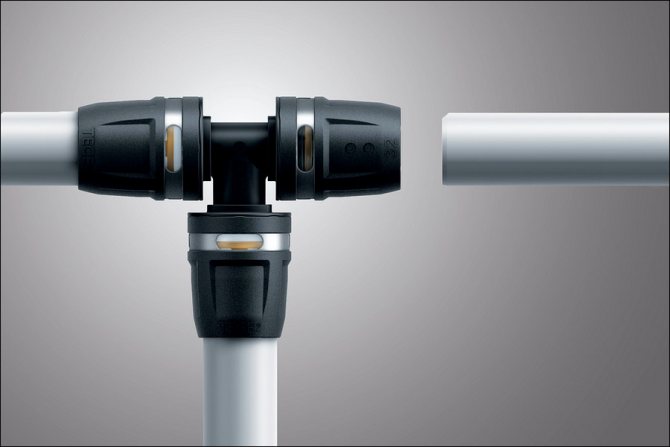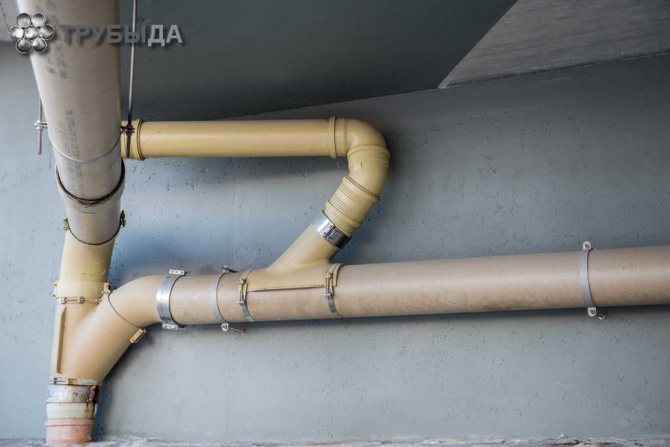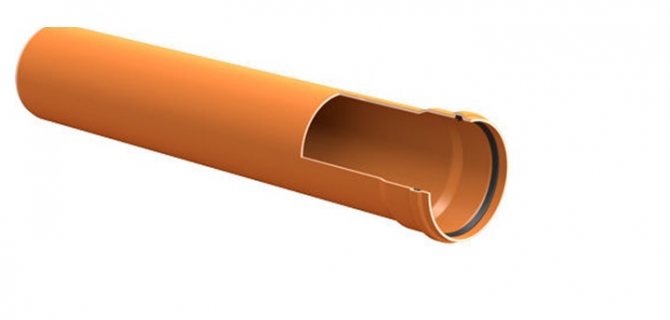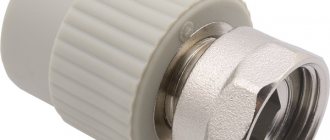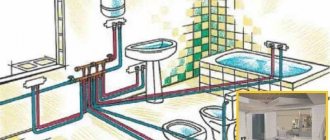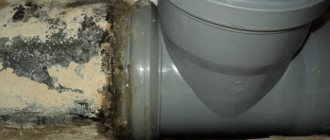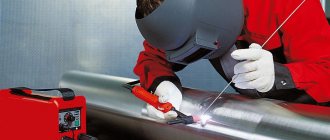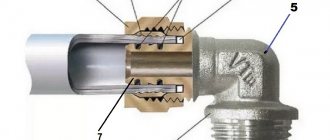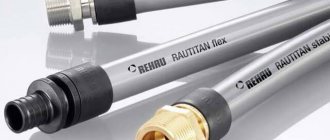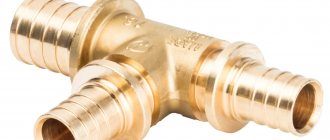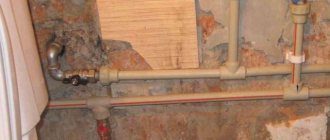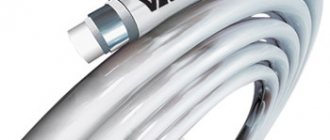Features of the method
A socket is a mounting extension at the end of a pipe. This design allows you to assemble a sealed and durable flow-through interface.
To do this, the smooth edge of one pipe is placed in the socket of the other. To achieve tightness, special seals are used. A socket joint with a rubber sealing ring is one of the used methods of installing sewer and water lines.
Pipes are also glued. But in this case, the reliability will depend on the resistance of the adhesive base to water.
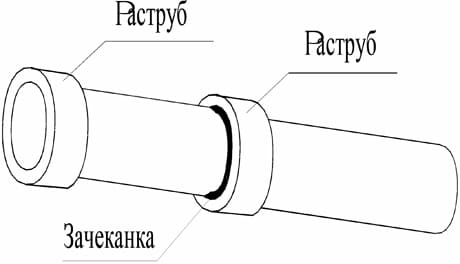
Connection and its features
The purpose of the study and development of the socket joint system is to simplify and improve reliability under the influence of longitudinal forces and internal pressure of the working medium.
The technical result is due to the fact that in the pipeline connection under consideration, the collar flange with a cone-shaped surface located at the smooth end, and the locking element with corresponding protrusions and slots, as well as the contacting surfaces of the pipes are made of conical shape and provided with an adhesive layer. The locking element, in turn, from the side of the slots mates with the conical part of the bell and is made in a split form.
The specified socket connection differs in that all the contacting surfaces are made in the form of a cone and are provided with an adhesive layer, as well as the function and execution of the locking element.
A socket joint with a rubber O-ring is used as the main type for the installation of internal sewage systems. The tightness, as in the previous cases, is due to the clamping of the sealing element between the surfaces of the socket and the spigot end.
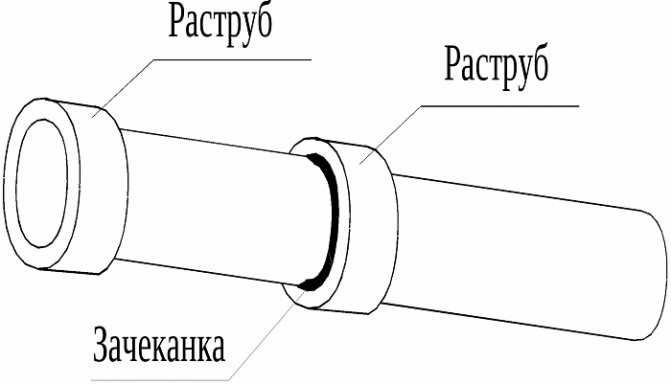

Socket connection of sewer pipes directed against the movement of sewage.
Rubber seals, with or without specially designed inserts, facilitate the installation of strong and tight connections.
The rubber ring allows you to compensate for the misalignment of the parts and their connection, however, if the seal ring is unevenly deformed, leaks can form. That is why, when installing hidden pipes, in particular, under a screed, special attention should be paid so that the curvature of the axis in the component sections of the pipeline is no more than the thickness of the pipe wall for each m of the sewer systems.
Many manufacturers offer 87 ° tees and elbows instead of 90 ° to avoid ring distortion. So that the ring is not damaged during installation, a chamfer is made at the inserted end and lubricated with a specially designed silicone grease (at worst, soap or glycerin, but in no case with oils).
Before connecting the sewer pipes, make sure that the edge of the pipe is provided with a chamfer, and the cast iron socket pipes are equipped with an O-ring, which must first be cleaned of contamination. A lubricant is applied to the spigot or fitting. Then the smooth edge is placed into the socket until it stops, at this stage it is necessary to mark the point of contact between the smooth edge and the socket. The pipe is pulled back 0.9 - 1.1 cm in relation to the position of the mark. This gap will compensate for the change in the length of the cast-iron socket pipe as a result of temperature influences, and, accordingly, prevent internal stresses in the sewer systems.
Flare connection options
Socket pipes can be made of various materials, small or large diameter. Considering these parameters, the most suitable connection options are applied.
Cement filling
This method is most often used for socket connection of cast iron pipes.
- The necessary measurements are made.
- The pipe is cut in such a way that the end face is free of cracks and notches.
- Then the prepared element is inserted into the socket.
- The gap inside it is closed using an oiled sealant (hemp or flax).
- Place the first layer of sealant in the pipe. In this case, the ends of the strands should not fall inside.
- Minify the seal using a hammer and screwdriver.
- Then carefully place the remaining layers of sealing material two-thirds of the depth of the socket.
- The last layer should be applied without impregnation.
- Fill the empty distance to the end of the pipe with cement mortar or asbestos-cement mixture. Also, cement can be replaced with silicone sealant, bituminous mastic or any other similar compound.
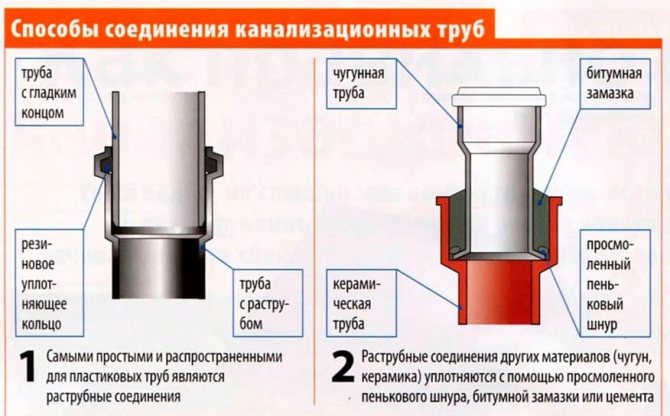

An alternative is another way of assembling cast iron structures. This is the filling of the sockets with expanding cement. Its advantages are:
- waterproofness;
- the ability to expand;
- self-sealing when hardened.
It should also be noted that the use of expanding cement significantly saves time during installation, since there is no need to caulk and stamp the joints.
O-ring application
This is one of the ways to connect plastic pipes. The rubber ring ensures tightness. It is clamped between the straight edge of the pipe and the walls of the socket.
The seal can be with special plastic inserts. But this is optional.
It is important to avoid deformation of the sealing collar on the ring. This can cause leakage in the joint area. Curvature of the axis is allowed, but it should not exceed the thickness of the pipe wall.
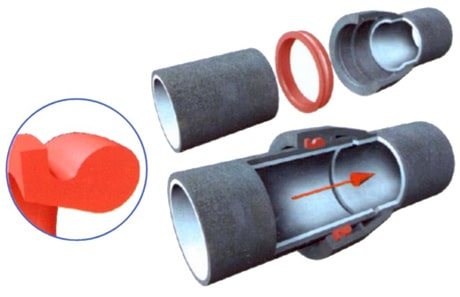

The ring may be damaged during installation. To avoid this, it must be lubricated with glycerin, silicone grease or soap. You cannot use oils for this.
The connection sequence is as follows:
- Clean the rubber ring.
- Place it in the socket groove.
- Lubricate the beveled end of the pipe with glycerin or ordinary soapy water.
- Insert it into the socket up to the mark.
- Check for a ring in the groove. To do this, turn one of the parts to be connected.
In the case of connecting pipes made of different materials, transition pipes are used.
A special tool or a hacksaw is used to cut pipes. Saw strictly perpendicularly, laying the pipe in the miter box. After that, a chamfer is removed from the cut end with a file at an angle of 15 °. This helps prevent damage to the O-ring during installation.
Installation using glue
Glue installation is quite simple. This should be done in the following sequence.
- Prepare pipe ends. Roughen them with a sandpaper.
- Degrease with methylene chloride.
- Prepare a special glue.
- Apply a layer of adhesive to the tapered section of the pipe and to the inner surface of the socket.
- Connect the mating elements and press them together.
- After a while, the glue will harden, providing the necessary tightness.
It is important to know that lateral loads are unacceptable with such a connection. They can break the adhesive layer.
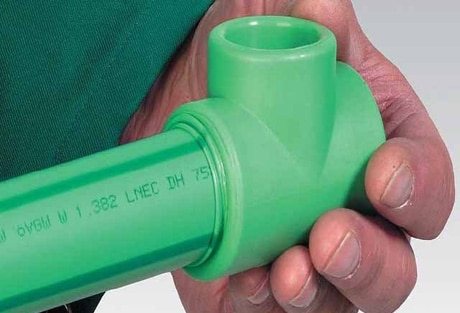

Two formulations of glue are recommended:
- First: perchlorovinyl resin (14-16 parts) and methylene chloride (84-86 parts by weight).
- Second: perchlorovinyl resin (14-16 parts), methylene chloride (74-76 parts) and cyclohexanone (10-12 parts).
It is important to know: open glue is suitable for only 4 hours due to the solvent content in its composition.
contact welding
Socket connection of pipes using resistance welding is a variant of joining parts made of various materials. It can be used for cast iron and steel as well as plastic pipes.
In this case, a manual or mechanical welding machine is used. It must be equipped with special devices for heating the elements to the required temperature.
This is a sleeve with which the outer part of the pipe is heated. And also a mandrel, which is designed to melt the inside of the part.
The sleeve-mandrel set must correspond to the diameter of the assembled structure.
Resistance socket welding is carried out as follows:
- Heat the cell with an electric current or blowtorch.
- At the same time, regulate the temperature using a thermal pencil, thermostat or pipe material - the element should melt, not burn.
- At the edges of the pipe fittings, chamfer 1/3 of the pipe wall thickness at an angle of 45 °.
- Install the stop clamp on the plain end at a distance of the socket depth plus 2 mm.
- Insert the mandrel of the heater into the socket, and push the sleeve to the stop on the smooth edge. The heating period will depend on the pipe wall thickness and material.
- Remove the molten parts from the sleeve and the mandrel at the same time.
- Connect together within 2-3 seconds.
- Do not rotate parts relative to each other.
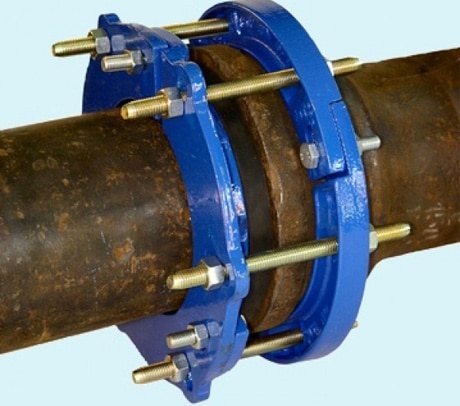

Socket connection of pipes and pipelines: PVC, HDPE, sewerage
In order to improve living conditions, all houses and apartments are equipped with water supply and sewerage. To bring hot and cold water supply, as well as sewerage, cast iron elements are used. Water pipes by their design have a small cross-section to achieve high pressure in the system, and sewer pipes are more massive and are used to drain sewage water. The most common are elements made of gray cast iron.
Due to the fact that the elements consist of cast iron alloys, they are subject to corrosion under the constant influence of water and humidity. In order to preserve the integrity of the elements for a long period of operation in production, they are coated with bitumen. This coating also helps reduce water friction and prevents dirt and debris from accumulating.
Due to the inability to use monolithic structures in water supply and sewerage, the socket method is used for joining pipes, in which one end of the pipe enters a slightly expanded end of the other. Therefore, the main issue is the way to ensure the tightness of the connections and the system.
In the presence of a bituminous inner coating, cast iron pipes become unusable during long-term operation, and also require replacement and reconstruction due to the inconvenient location of the entire pipe system in the room.
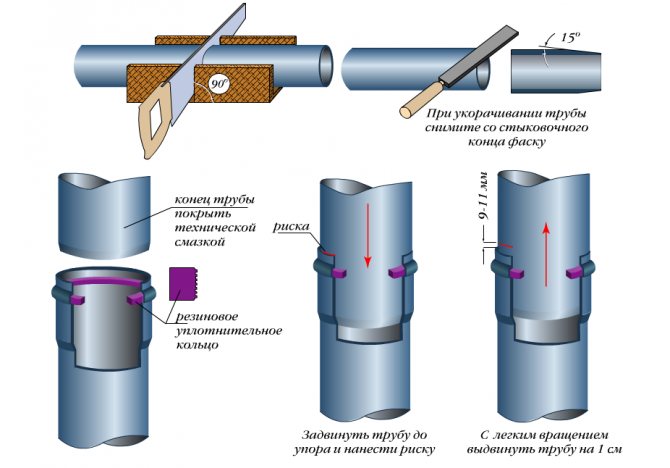

Often, when dismantling the old system, the existing cast-iron elements are no longer used for repairs and are replaced with newer and higher quality ones. Cast iron elements can be checked by visual inspection and tapping in different places, while all surfaces must be clean and smooth. Particular attention must be paid to the quality of the application of the inner protective layer.
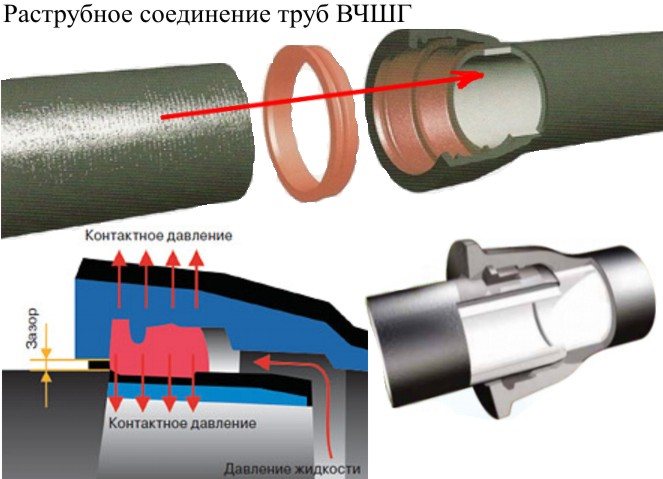

Currently, manufacturers of cast iron products produce a wide range and for a high-quality replacement it is necessary to accurately measure the system and determine the length of the pipes and the number of elements.
The cast iron elements are connected to each other and sealed the gap between the pipes at the junction using cement mortar. The ends of the pipes must be clean and free from any droplets of paint or solution.
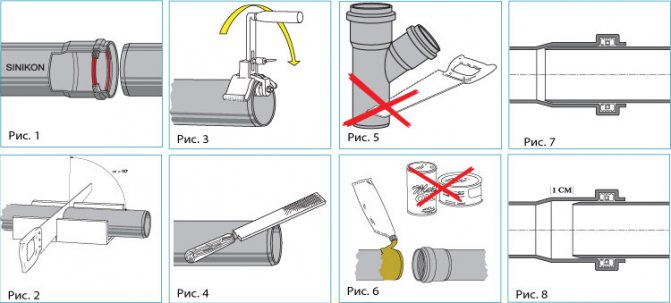

Before connecting the pipes, several resin strands are wound around the end of the inserted pipe (narrow end) and a small bundle of rings is made. Then it is tightly driven into the socket of the other pipe.For a better entry of the pipes, it is screwed in, but at the same time they monitor the correct position of the pipes and wound strands. The ends of the bundle should not get inside, and when winding them, they should be directed upward from the socket in advance. Only after the pipe is fully seated, the ends of the strands and the bundle must be hammered into the gap and lowered to a depth of up to two-thirds of the height of the socket.
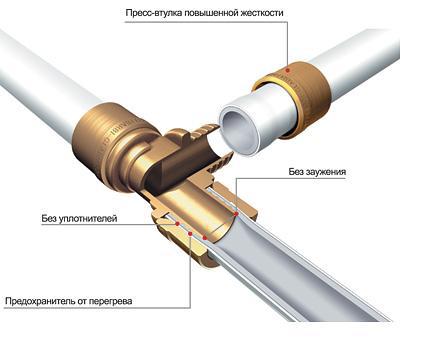

After these works, a cement slurry is prepared at the rate of nine parts of cement to one part of water. For such a solution, cement of a grade of at least 300 is taken. The finished solution is introduced into the gap with a spatula or scoop and filled tightly with a hammer and chasing. For better drying of the solution, the junction is wrapped with a wet rag. In the summer, it is necessary to monitor and prevent its premature drying, and in the winter, they make sure that the junction does not freeze, and, if possible, heat it up.
In connection with the development of technologies for the production of building materials, it has now become available to use expanding cement mortar to seal the gap between the cast-iron elements. This greatly facilitates the work of sealing the joint and gap. But there are some features of the use of such a solution.
So after connecting the pipes, three or more identical wedges are driven in a circle into the gap to center the location of the upper pipe. The mortar is prepared at the rate of three parts of cement to seven parts of water. Otherwise, the steps remain the same as in the previously described installation process.
In addition to cast iron elements, parts of various polyethylene and polypropylene began to be used in the internal water supply and internal sewerage system. This is due to its high resistance to water and moisture, as well as due to the smooth inner side, which ensures the best sliding of water and the drainage of sewage water.
Due to its good plasticity, such a material easily acquires the desired shape and geometry in a limited space. Rubberized sealing rings are installed in the sockets of plastic pipes, which facilitates installation and provides the necessary tightness. After inserting the pipe, you just need to turn one element around the other to check the correctness of the installation, and the ring will be in the desired groove.
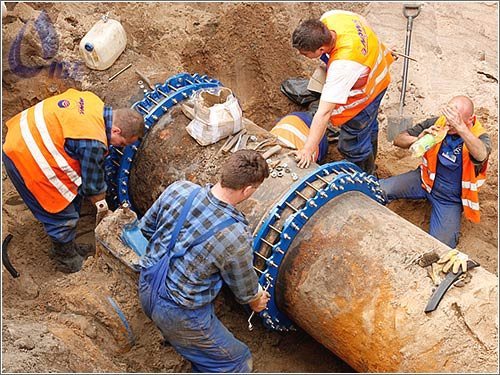

To connect such pipes, special glue and tools can be used. In this case, prepare the ends of the pipes and give them a rough surface with a sandpaper. Further, the surfaces are degreased by treating with a special agent, and then glue is applied and the ends of the pipes are tightly and strongly squeezed until they are completely glued.
But plastic pipes have several disadvantages. One of them is intolerance to mechanical stress, and under the influence of great forces, the material can break. Second, it can be noted that at low temperatures the material becomes brittle and can break when installed under such conditions. Another disadvantage is ductility and elongation when exposed to high temperatures, which cannot be said about cast iron elements.
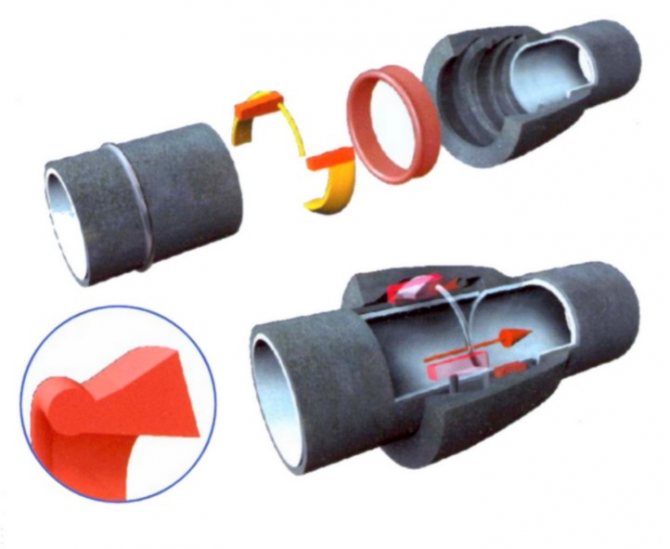

Based on this, plastic elements can only be used indoors in water supply and sewerage. Due to the widespread use of plastic elements in the sewage system, it is necessary to remember about some features. So, to ensure the tightness of the joint between the sewer outlet and the pipe, rubber rings are used, and then the joint is covered with cement to a third of the socket height. At the junction of the siphon with a plastic pipe, a rubber element is used, which enters the bell. Knowing the subtleties and aspects of joining some cast iron or plastic structures, you can perform the work of replacing systems and their parts with a new one, on your own and at the lowest cost.
When to apply the re-sealant
An additional seal for the socket joint of cast iron pipes is used in two cases:
- for additional sealing during installation;
- to eliminate leaks arising during operation.
As a result of a violation of the tightness and integrity of the minting, a leak is formed at the pipe joints.
The re-compactor is considered more reliable than chasing. It is suitable for sewerage and water supply networks. Consists of breakable cast iron rings, rubber gasket and long bolts with nuts.
Troubleshooting is carried out without reducing the pressure in the line in any weather.
Appointment
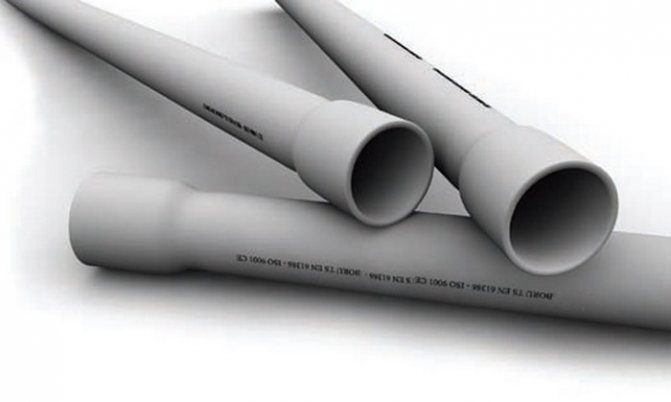

A funnel is a funnel-shaped expansion at one end of a sewer pipe. Thanks to this extension, the pipes can be installed correctly and quickly. As a rule, a socket joint is used on pipes made of:
For asbestos-cement and concrete pipes, such a connection is also sometimes used, but rather rarely. The essence of the installation is that one end of the pipeline is simply inserted into the funnel-shaped expansion at the end of the adjacent pipe. To make the connection tight, additional methods of waterproofing the docking point are used. The choice of this or that method depends on the material from which the pipes are made.
Important: this method of joining pipes is used when installing both external and internal sewage networks.
The main purpose of the socket and the functions assigned to it are as follows:
- With its help, the installation of the pipeline is greatly facilitated and accelerated.
- Leak-proof and leak-tight connection.
- With its help, fittings are connected to pipes.
- Thanks to the socket, elements from different materials can be connected into one system without using fittings.
- When arranging external networks, the bell acts as additional stiffeners, thanks to which the system is protected from deformation and damage.
- When dismantling, the socket connection of pipes makes it possible to do without sawing the elements.
- Flared pipes can not only be quickly assembled, but also dismantled in case of repair or replacement.
Attention: despite such an abundance of functions and advantages, socket structures are not used everywhere. For example, pipelines made of elastic materials are connected according to a different principle. The same is true for some types of pipes made of solid materials.
What is a bell?
This is the name of a slight broadening on one side of the communications. The second end of the product always has a flat surface. This is due to the intricacies of the installation. If you are interested in the question of what a socket is, you need to learn more about the configuration of this part of the product. It has a funnel shape. When choosing pipes, you should take into account the diameter of the straight section and the socket, because the connection will be made at this location.
There are different types of communications with broadening at one end, different in material:
- polymer;
- metal (cast iron, steel);
- ceramic;
- asbestos concrete;
- reinforced concrete.
During installation, the smooth end of the product is inserted into the socket. To create a tight connection, a rubber seal is provided. It fits into a special annular groove. When purchasing pipes, a seal is provided in the kit. As a result, installation is carried out quickly and without additional funds. For comparison, socketless sewer pipes are connected using special equipment (welding machine for metal, soldering iron for polymer material).
The easiest way is to connect polymer communications with each other. Products made from other materials often require the use of aids. These can be seals or special compounds, mixtures.
The socketless connection is characterized by low reliability. If you plan to use communications without broadening on one side, it is recommended to use shaped elements.They overlap the seam joint, thereby slightly increasing the strength of the pipeline.
The bell is a multifunctional element. With its help, various tasks are solved:
- increasing the speed of installation work;
- protection against leaks;
- simplification of the process of connecting pipeline elements;
- ensuring the possibility of joining pipes made of different materials;
- in the areas where the socket is located, an additional stiffening rib is formed, which makes it possible to increase the reliability of the system;
- simplification of the dismantling process, if it is necessary to replace old pipes or clean the pipeline.
Methods for mounting a pipe with a socket
A pipe with a socket can be metal or polymer, of small and large diameter, designed for a gravity or pressure pipeline. In a word, pipes with an assembly extension (socket) at the end are different, but this vast assortment has one thing in common. Such pipes make it possible to assemble a strong and sealed flow-type interface literally with one movement. To do this, you just need to place the smooth end of one pipe in the socket of the other.
And in this article we will consider a socket connection of pipes made of different materials, supplementing this information with an overview of fittings with an assembly expansion (socket).
Installation of sewer pipes
The connection of sewer pipes by socket welding is carried out as follows.
- The element is heated by means of an electric current, a gas burner or a blowtorch to the temperature required in a particular case (for steel, cast iron, plastic and other pipes).
- Temperature regulation is carried out with a thermal pencil, thermostat or pipe material (in the process of conjugation with the heated surface of the element, it melts, but does not burn, that is, there is no smoke).
- At the ends of the pipeline fittings, a chamfer is removed, which is 1/3 of the pipe wall thickness, at an angle of 45 °.
- On the plain end, a restrictive clamp is installed at a distance equal to the depth of the socket, plus 2 mm.
- The mandrel of the heater is inserted into the socket, and the sleeve is pushed all the way onto the smooth edge. The heating period depends on the material and wall thickness of the pipe fittings.
- The molten parts are simultaneously removed from the sleeve and mandrel and connected together within 2-3 seconds.
- The parts are held under load for about 30 seconds until the material is completely hardened.
At the end of the process, the parts should in no case be rotated relative to each other.
Types of socket pipes
The following types of pipes are produced with mounting thickening:
Connecting cast iron pipes with a socket
- Polyvinyl chloride fittings with a diameter of 63 to 315 millimeters (for an O-ring) or from 10 to 160 millimeters (for an adhesive joint). The assortment of such products is determined in accordance with GOST 51613-2000. Moreover, pipes for a rubber sealing ring are used only in free-flow networks, but fittings for a glue socket are recommended for use even in pressure pipelines.
- Cast iron fittings with a diameter of 50 to 150 millimeters. The range of such fittings is standardized in accordance with GOST 6942.0-80. At the same time, the socket connection of cast iron pipes is used not only in the assembly of sewer pipelines. There is another type of cast iron pipes with a socket, the nominal diameter of which ranges from 65 to 1000 millimeters. Such pipes are standardized in accordance with GOST 9583-75 and are used in pressure-type pipelines.
- Ceramic fittings for sewers, with a diameter of 150 to 600 millimeters with a ribbed inner surface of the mounting bulge and the same shoulder of the bell. The range of such pipes is standardized by GOST 286-82
In a word, as you can see, socket pipes can be found anywhere - both underground and above the ground, and in structures, and in oil wells.Therefore, the methods of sealing socket joints simply cannot be of the same type. And further in the text we will consider the options for ensuring the tightness of the socket joint.
Sealing a flare connection: overview of options
The tightness of the socket joint is ensured by gaskets, adhesive bonding, additional seals and conventional welding. Moreover, the rings (sealing and retaining), as well as the slip flanges, provide for the detachable installation of the socket interface, and the welding and glue assembly - the one-piece assembly option.
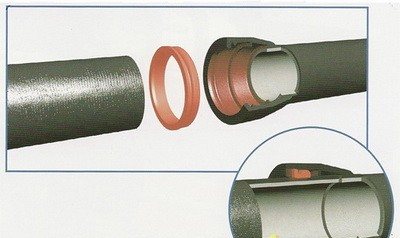

O-ring mounting
Well, the details of these technological processes are as follows:
- Mounting on an O-ring is carried out as follows - an O-ring is placed in the socket, placing it in the inner groove; the smooth end of the pipe is pushed with effort through the ring into the socket. As a result, the pipe pushed into the socket expands the ring and wedges in the mounting bulge. True, such a joint will only withstand atmospheric pressure, therefore this technology is used only when assembling sewer or branch pipelines. But such a method of joining will withstand transverse deformations better than other methods of one-piece mounting.
- A special case of mounting on a seal is the fixation of cast iron pipes with tow, driven into the gap between the socket and the pipe. Moreover, after chasing (this is the name of this operation), a layer of bitumen or cement is applied to the end of the socket.
Installation of pipes with a socket on glue
- An analogue of embossing, implemented in polymer pipelines, is installation in a socket using a retaining ring. In this case, a rubber ring is moved to the joint of the pipe and the socket - an additional seal for the socket connection of cast iron pipes, which is made from a flat tape (the excess edges are cut off). Then, on both sides of the socket joint, detachable clamps are mounted, created in the form of segmental washers. By assembling these segmental washers, a semblance of a flat flange can be obtained. And one such "flange" is mounted behind the bell, and the other - butt to the rubber seal. By screwing in the mounting studs of this "flange" connection, the seal ring can be immersed in the gap between the pipe and the socket. And thanks to the elasticity of the additional seal (rubber ring), such a connection will withstand both lateral and longitudinal deformation.
- Glue installation is very simple. The first layer of glue is applied to the tapered section of the pipe, and the second layer of adhesive is applied to the inner surface of the socket. After that, the pipe is inserted into the socket and the mating elements are pressed against each other with considerable effort. After some time, the adhesive layers will harden and the joint will become airtight. True, lateral loads with this method of installation are categorically contraindicated. They can destroy the fragile adhesive bond.
Resistance socket welding is carried out using special devices - soldering irons. The heating element - a tire - of such a device is equipped with low-melting nozzles: a nipple, the diameter of which coincides with the internal dimensions of the socket, and a coupling, the through-hole of which coincides with the external diameter of the pipe.
By heating the corresponding parts of the socket joint of thermoplastic pipes on the nipple and in the sleeve, we achieve the destruction of polymer chains. And by pressing the heated pipe into the same socket, and leaving the connection alone for 10-15 minutes, we create conditions for the emergence of new polymer chains.
As a result, socket welding is the most reliable technology for installing polymer reinforcement.
Pipe connection technology using electrofusion couplings
The technological process of welding polyethylene pipes with electrofusion fittings is not difficult - the pipes are inserted into the fitting, fixed and supplied to the terminals with electric current.
The algorithm can be schematically indicated as follows:
- The pipes are prepared for connection. They are cut to size, making a cut at right angles to the pipe axis.
- The cut is cleaned, freed from dust, particles of material, moisture.
- Pipes are inserted into an electrofusion sleeve.
- Connect the fitting to an uninterruptible voltage source.
- Allow the joint to cool. The average cooling time is about half an hour.
- Check the reliability of the connection obtained. For this, the joints are coated with thick soapy foam and compressed air is fed into the system.
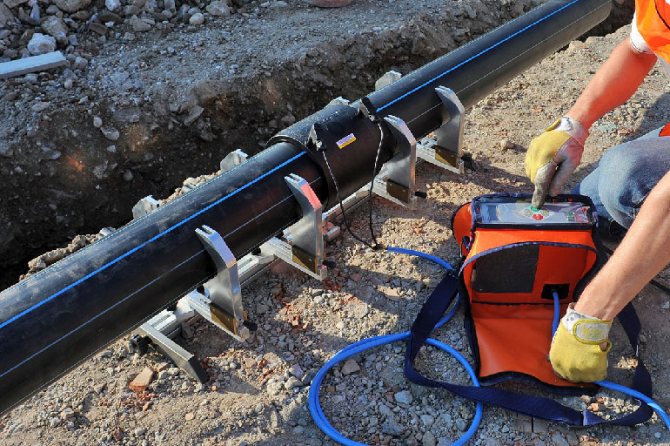

The nuances of the location of pipes in the coupling:
- if the fitting has restrictive protrusions, then the pipe is inserted strictly up to the mark;
- if there is no limiter, then one should be guided by the thickness of the pipe wall - the distance between the cuts of the pipes to be connected should not be greater than the wall thickness of the pipe material;
- the joint should be located in the middle of the sleeve;
- to maintain the distances, a circular mark is drawn on the outer wall of the pipe or at risk.
Note! The electrofusion coupling is non-separable. Carelessness in the preparatory work during installation can cause damage to an expensive fitting.
The welding process takes place in automatic mode. After connecting, check the reliability of the joint. For this, the compound is coated with soapy foam and the carrier is supplied under pressure. If the joint does not begin to bubble, then the joint is sealed.
Advantages of electrofusion fittings:
- Ease of installation. Availability of work to be performed by a non-professional.
- Ability to dock the pipeline in a trench, other hard-to-reach places.
- Automation of the process eliminates the human factor during installation.
- The service life of the pipeline depends only on the materials.
We recommend that you familiarize yourself with: Welding methods for joining polyethylene pipes
The disadvantages include the high cost of fittings. However, the costs are paid off by saving on outsourcing.
Socket pipes: purpose, types, practice of application
Socket pipes are widely used in industry, urban planning facilities, where it is required to organize pipeline systems for various purposes. In modern construction, it is very important to arrange the so-called zero cycle - the foundation that prepares the site for installation work on the construction of the facility. At this stage, the construction of underground utilities is not complete without the use of structures such as a bell pipe.
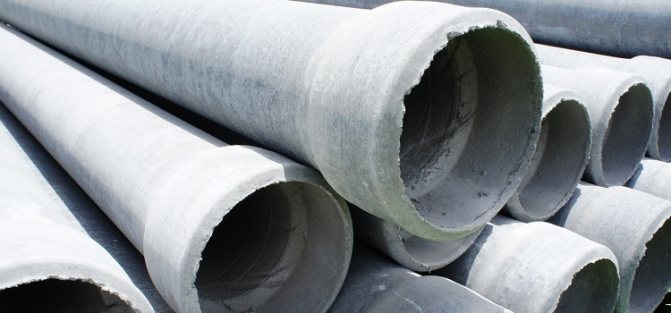

Pipes with a socket make it possible in the shortest possible time to install highways for various purposes
Areas of use for flared pipes
Transportation of liquids, sewerage system, stormwater system is impossible without the use of a special type of pipes. The socket design is reliable and easy to use, relatively inexpensive to manufacture and practical to operate. Its use is ubiquitous:
- industrial and civil construction;
- hydraulic engineering works in various directions;
- road construction;
- construction of railway facilities and tracks;
- Agriculture.
Pipe structures are made from various materials. The main ones that have become firmly established in the practice of application are concrete, cast iron and plastic. Each of the types has its own advantages and disadvantages. The technical characteristics of these products determine the scope of their application.
Types of socket pipes, their quality characteristics
A pipe with a bell, besides all other advantages, has the main advantage - ease of installation, manufacturability in operation, relatively low costs for the installation of products.
Concrete products are especially popular. Their cost becomes lower as the produced pipe diameter increases. The bell system itself is very practical. An extension is formed at one end of the pipe, which serves as a seat for the other pipe. The joint is sealed in a manner that is most effective for this type of product.
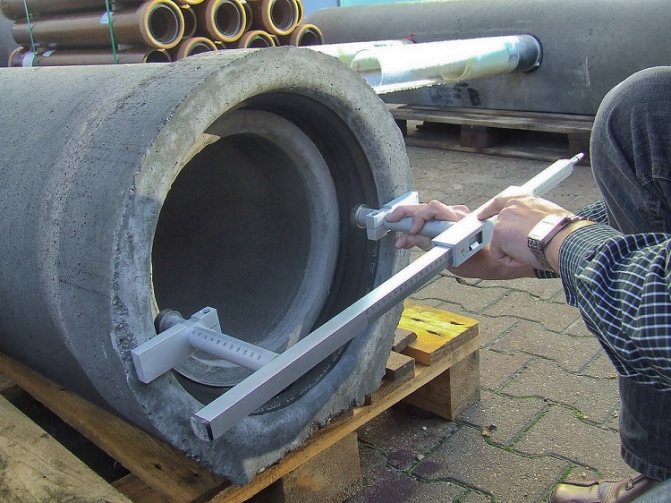

Bell-shaped products have an extension at the end, into which the edge of the subsequent pipe is inserted
Concrete and cast-iron pipe connections are coined with concrete and resin-filled sealing compounds, and plastic ones - with rubber O-rings that secure the assembly connection. For concrete and cast iron products, special rubber seals can also be used. They improve the tightness of the connection, making them moisture resistant.
Note! The sockets in the piping system are located against the direction of fluid movement.
As a rule, cast iron and plastic socket systems are installed for sewerage and other indoor systems. Concrete products are most often used in external sewer or drainage collectors. Large diameters are usually required there, capable of freely carrying bulk liquid masses.
Socketless pipes, their connection, principles of use
Socketless pipes are also popular and practical to use, install and operate. The fundamental difference from the socket versions is that the pipes are assembled using additional devices that ensure the connection and sealing of the joint.
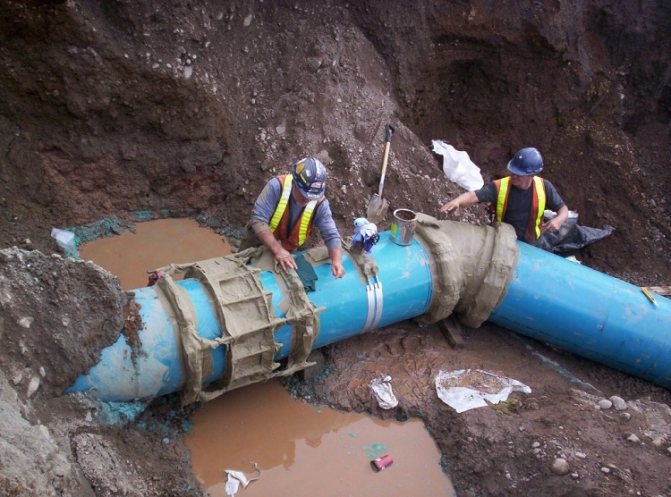

Socketless pipes are connected using couplings, collars and other fittings
For reinforced concrete structures, a concrete flange serves as such a connecting element, and a clamp for cast iron pipes. The absence of a socket in some cases simplifies the installation of the pipeline, reduces the construction time. Basically, such products are used in the construction of free-flow systems. But, using special cuffs that increase the degree of sealing and strength, pipelines can perform the functions of pressure, that is, keep the pressure of the internal environment. The main application of such products is drainage or socketless sewage.
Tools and accessories for installation
To install a pipeline using electrofusion fittings, you will need tools:
- for cutting pipes - a pipe cutter or a hacksaw for metal;
- sharp knife + sandpaper or beveller for cleaning the cut from burrs, irregularities;
- acetone or organic solvent, rags for removing dust and degreasing the joint.
The welding process itself requires the supply of a certain current to the terminals. For this, a professional welding transformer is used. It belongs to the expensive special equipment. For the installation of individual communications, such an electricity transformer can be rented.
We recommend that you familiarize yourself with: How to choose an adhesive for a high-quality connection of PVC pipes?
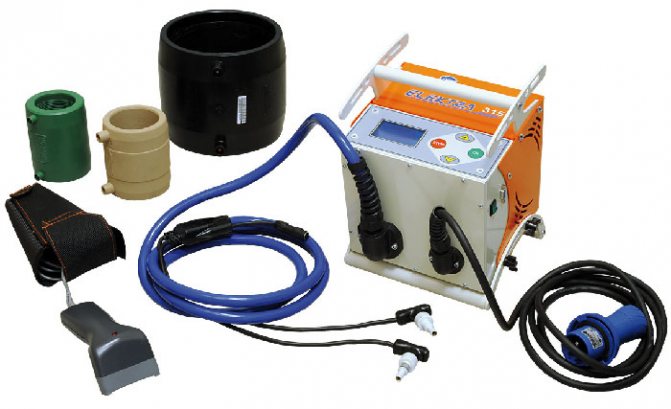

The welding machine can be easily adjusted to the required voltage. In most modern welders for plastic materials, the adjustment is carried out automatically, according to the barcode on the electrofusion fitting. Advanced models read information directly from the coupling terminals.
Assortment of concrete products. Manufacturing features
Concrete socket pipes are used in civil and industrial construction. They are inexpensive, practical, durable in use. Most often they are used in the construction of sewerage systems, urban stormwater systems, bypass pipelines for water in road construction.According to their purpose, reinforced concrete products are divided into:
- free-flow;
- pressure head;
- designed for all types of road construction.
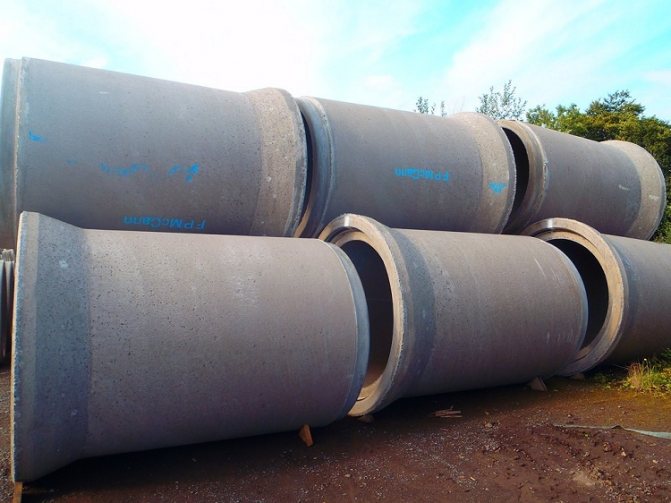

Socket pipes made of concrete are of the pressure and non-pressure type
The industry produces three main types of socket pipes: type T, type TB and type TV. They differ in the method of production, load characteristics, and other special parameters provided for by GOSTs.
Reinforced concrete gravity pipes of type T are used for laying sewer systems, drainage systems for ground and underground waters, and other non-aggressive liquids for this product. They can withstand significant loads, are inexpensive in terms of manufacturing cost, and include available materials.
The TB type is capable of carrying an increased load during operation. They can be supplied with rubber O-rings, which simplify the installation of the connections, making them tight.
Important! Such pipelines can be used as pressure pipelines for pumping water and other liquids that are neutral to the concrete composition.
For example: the most used pipe dimensions are socket products 5 m long, 1 m in diameter and 75 mm thick. They are optimal from the point of view of the construction of the sewer collector, make up a convenient load for transportation by car - 5 pieces each on a specialized platform.
Pipes of the TV type are intended for use in road construction. These are especially durable products, complete with O-rings, capable of withstanding the pressure of the soil layers and the work of the road deck for a long time. They are divided into four groups according to their bearing characteristics:
- Group 1 - the ability to bear the pressure of the backfill soil and the roadbed up to 5 meters thick;
- Group 2 - load capacity up to 10 meters;
- Group 3 - load capacity up to 15 meters;
- Group 4 - up to 20 meters of backfill thickness.
Flared sewer concrete pipe is a rigid and reliable structure with a service life of more than 50 years. This is what makes it a special technology of using durable concrete, special structural reinforcement and high-tech manufacturing methods. The price-quality ratio of this structure is optimal, therefore, most design and construction organizations, when looking for the necessary pipes for organizing the construction of hydraulic systems, opt for concrete products.
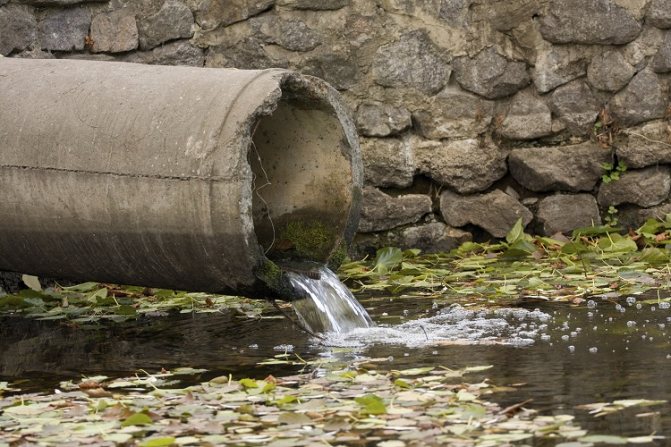

Concrete pipes with and without socket are most often used in drainage and sewerage systems
Design features
Electric-welded coupling for polyethylene pipes is a cylinder made of low-pressure polyethylene. The inner diameter of the coupling is slightly larger than the outer dimensions of the pipes to be connected. Electric-welded coupling PND 100 is designed to connect straight sections of a polyethylene pipeline of the same diameter.
Manufacturers offer a size range of welding fittings from 20 mm in diameter to 900 mm. The length of a small fitting depends on its diameter in a ratio of 1: 2.5. For example, an electrofusion sleeve for pipes with a diameter of 20 mm will be 50 mm long. The length of the maximum diameter welding fitting is slightly larger than its values. So a coupling with a diameter of 800 mm has a length of 90 cm. The length of a coupling for 900 mm is 1 m. Manufacturers offer electric-welded couplings with an elongated body.
We recommend that you familiarize yourself with: How to correctly and securely connect a metal pipe with a plastic one?
Inside the fitting there are electric heating coils, the contacts of which are brought out in the form of terminals. The material and location of the heating elements of the electrofusion sleeve prevent heat from spreading to the outside of the part.
The welding process is provided by melting polyethylene under the influence of temperature. The molecular diffusion process affects the inner surface of the sleeve and the outer wall of the pipes.Polyethylene is melted to a specific depth and mixed at the molecular level. When solidified, a monolithic formation is formed, which has no visible interface.
The part can be equipped with a welding progress indicator. This allows you to track the connection process and simplifies work. Fasteners on the electrowelded coupling allow you to securely fix the part on the pipes, which eliminates rejects at the joint.
The fitting has a special barcode on the tag, which is read by the scanner of the welding machine. According to the barcode information, the device sets the heating time and temperature to obtain a perfect joint.
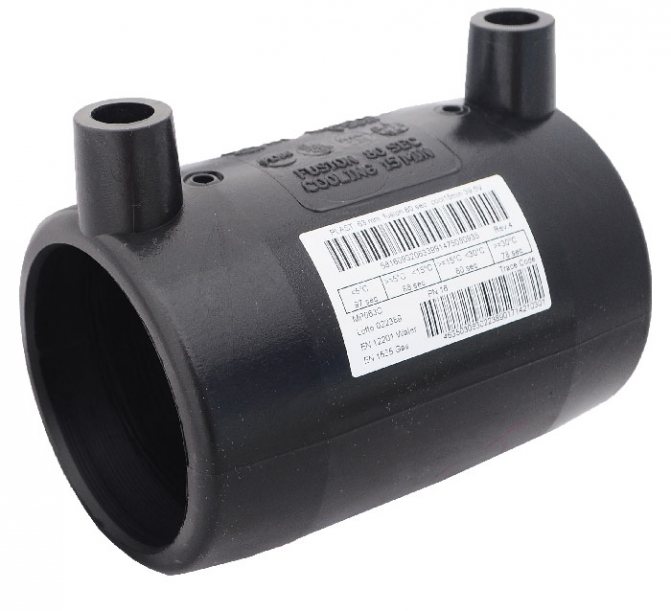

Since the welding process is provided by molecular diffusion of molten polymer, the composition of low-pressure polyethylene in the body of the electrofusion sleeve is of great importance. The overwhelming majority of fittings are made of polyethylene of grade 100, but there are also couplings of 80. Fittings of grade 100 are considered universal. They are allowed to be used for any HDPE pipes.
Note! For a high-quality connection of HDPE pipes with electrowelded couplings, purchase pipe material and fittings from one manufacturer. This will ensure the complete affinity of the polymers.
Cast iron and plastic socket systems
The use of cast iron and plastic flared pipelines has long been rooted in construction practice. The cast iron pipe is a long-standing structure that provides a drainage system, drainage. Even in our very technological time, it is often applicable for the same purposes. Both cast iron and plastic are used in internal drainage structures and sewage systems.
A cast iron pipe is often used as a reliable protection for cable networks when laying them underground. It protects the contents from moisture and mechanical stress, is not subject to combustion. When protection from the cold is required, a special insulation is used. One of the disadvantages of a cast iron pipe is its susceptibility to corrosion. For long-term operation of such a pipeline, corrosion-resistant insulation is required.
Recently, socket types of plastic pipes have been massively used. They are very practical, lightweight and have almost the same characteristics as cast iron pipes, except for mechanical stability. In their manufacture, polypropylene, polyvinyl chloride, high or low pressure polyethylene are used.
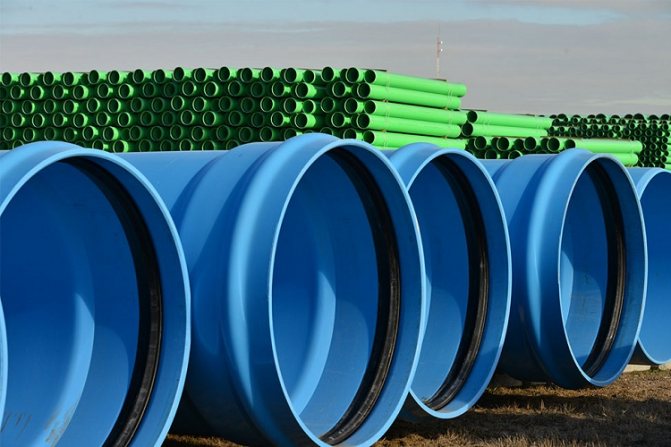

Polymer pipes are completed with rubber bands in the socket, which greatly simplifies and speeds up their installation
The scope of application of these pipes is the same as that of traditional cast iron or concrete structures. The difference is in the technological capabilities of the pipe material. Modern fixation of the socket joint is carried out using a rubber O-ring, which ensures the sealing of the joint. Welding connection is also possible. The multicolored design gives the pipes an aesthetic appearance and indicates its purpose in the piping system. One of the important advantages is that plastic systems are not susceptible to corrosion.
Practical application of socket pipes
Socket products are widely used for organizing pipeline systems designed to transport liquids in the pressure and non-pressure modes of use. Reinforced concrete structures of large diameter are used for sewerage, drainage of rainwater from city streets. Cast iron and plastic systems have the same purpose, only, mainly, inside buildings, structures, various civil objects, private estates.
Pipelines are used as protective transport systems for wiring cables, routing heating and other types of technological networks. Almost all types of socket pipes can withstand a wide range of temperatures and pressures of surface earth masses.Well-sealed structures provide the required internal pressure of the liquid composition transported through the pipeline.

